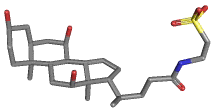|
TAUROCHOLIC ACID |
| Synonyms. Taurocholic acid; 2-(((3alpha,5beta,7alpha,12alpha)-3,7,12-Trihydroxy-24-oxocholan- 24-yl)amino) ethanesulphonic acid; 2-((3-alpha,7-alpha,12-alpha-Trihydroxy-24-oxo-5-be ta-cholan-24-yl)amino)ethanesulfonic acid; 3alpha,7alpha,12alpha-Trihydroxy-5beta-cholanic acid 24-taurine; Acidum cholatauricum; Cholaic acid; Cholic acid taurine conjugate; Cholyltaurine; N-Choloyltaurine; Taurocholate; |
|
|
| PRODUCT IDENTIFICATION | |
|
CAS RN |
81-24-3 (free base), 145-42-6 (sodium) |
|
EINECS RN |
201-336-2 (free base), 205-653-7 (sodium) |
|
FORMULA |
C26H45NO7S |
|
MOLE WEIGHT |
515.70 |
|
H.S CODE |
2924.29.9500 |
|
SMILES |
C1[C@H]2[C@H]3[C@@H]([C@@]4([C@@H](C[C@H](O)CC4) C[C@H]3O) C)C[C@@H]([C@@]2([C@H]([C@@H](CCC(NCCS(O) (=O)=O)=O)C)C1) C)O |
|
CLASSIFICATION |
Choleretic, Gastrointestinal agent, Surface active agent, Bile acid |
|
EXTRA NOTES |
The product of conjugation of cholic acid with taurine. Its sodium salt is the chief ingredient of the bile of carnivorous animals. It acts as a detergent to solubilize fats for absorption and is itself absorbed. It is used as a cholagogue and cholerectic.[MeSH] |
|
|
| PHYSICAL AND CHEMICAL PROPERTIES | |
|
PHYSICAL STATE |
white to off-white crystalline powder |
|
MELTING POINT |
125 C |
|
BOILING POINT |
|
|
DENSITY |
|
|
SOLUBILITY IN WATER |
|
| SOLVENT SOLUBILITY |
|
|
VAPOR DENSITY |
|
|
log P(octanol-water) |
0.01 |
|
VAPOR PRESSURE |
|
|
AUTOIGNITION TEMP |
|
| pK |
|
|
REFRACTIVE INDEX |
|
|
FLASH POINT |
|
|
|
| STABILITY AND REACTIVITY | |
| STABILITY | Stable under normal conditions. |
|
INCOMPATIBLE MATERIALS |
Strong oxidizing agents. |
| POLYMERIZATION |
Has not been reported |
|
NFPA RATINGS |
Health: 1, Flammability: 1, Reactivity: 0 |
|
|
| EXTERNAL LINKS & GENERAL DESCRIPTION |
|
USA.gov - Taurocholic acid Wikipedia Linking - Taurocholic acid Google Scholar Search - Taurocholic acid U.S. National Library of Medicine - Sodium taurocholate PubChem Compound Summary - Taurocholic acid Drug Bank - Taurocholic acid KEGG (Kyoto Encyclopedia of Genes and Genomes) - Taurocholic acid ChEBI (http://www.ebi.ac.uk/chebi/) - Sodium taurocholate NCBI (http://www.ncbi.nlm.nih.gov/) - Taurocholic acid Material Safety Data Sheet - Taurocholic acid Human Metabolome Database - Taurocholic acid Hazardous Substances Data Bank - Taurocholic acid EPA - Substance Registry Services - Taurocholic acid |
|
|
| SALES SPECIFICATION (Sodium taurocholate) | |
|
APPEARANCE |
white to off-white crystalline powder |
|
ASSAY |
97% min |
|
LOSS ON DRYING |
7.0% max |
| OPTICAL ROTATION |
+19° ~ +26° (c=3, water) |
|
pH |
6.5 ~ 9 |
|
HEAVY METALS |
20 ppm max |
|
|
| TRANSPORT & REGULATORY INFORMATION | |
|
UN NO. |
|
| HAZARD CLASS |
|
| PACKING GROUP | |
|
|
| SAFETY INFORMATION | |
|
HAZARD OVERVIEW |
GHS (Globally Harmonised System) Classification: Not a dangerous substance. Potential Health Effects: Eyes - May cause eye irritation. Skin - May be harmful if absorbed through skin May cause skin irritation. Inhalation - May be harmful if inhaled. May cause respiratory tract irritation. Ingestion - May be harmful if swallowed. |
| HAZARD CODES |
|
|
RISK PHRASES |
|
|
SAFETY PHRASES |
|
|
|
| PACKING |
|
Preserved in light-resistant and well-closed bottles |
|
|
| PRICE INFORMATION |
|
|
